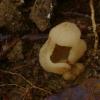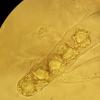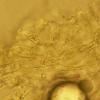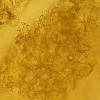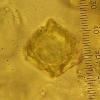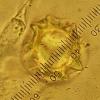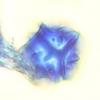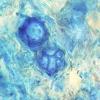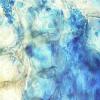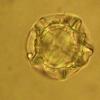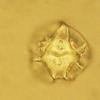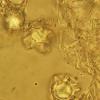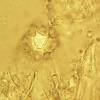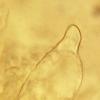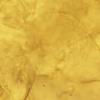
21-12-2025 09:32
Hello.A tiny ascomycete found embedded in wood in

21-12-2025 21:32
Pol DebaenstHello, Garden, Burgweg 19, Veurne, BelgiumOn 10/1

22-12-2025 23:38
Patrice TANCHAUDBonsoir, récolte sur un mur en pierre, apothéci

22-12-2025 00:47
Patrice TANCHAUDBonsoir, récolte à proximité du milieu dunaire

21-12-2025 21:40
Isabelle CharissouBonjour, j'aimerais connaitre les références de

20-12-2025 23:08
Patrice TANCHAUDBonsoir, récolte sur sol sablonneux dans l'arri�
Tropical asco
Zuzana Sochorová (Egertová),
23-06-2015 21:32
 Hello,
Hello,this fungus was found in a tropical lowland dipterocarpous forest of East Kalimantan. It was a single fruitbody partly hiden in the soil, irregularly shaped, beige, hollow, with two holes, measuring 26 mm in the broadest part.
It has a strange structure under microscope, quite difficult to read for me. I can see there a layer of globose-angular, thick-walled cells (20-43 micrometers, the walls up to 2 micrometers) and a layer of thin cylindrical cells running in different ways (3.5-7 micrometers broad).
Spores are yellowish, globose, ornamented with isolated warts, tubercles and high ridges resembling wings (up to 6 micrometers high), measuring 14.5-15.5 micrometers without ornament, 22-25 including ornament.
Asci are non-amyloid, octosporic, uniseriate.
What could it be? It resembles Ruhlandiella with the spores, but the asci are not amyloid and the shape is "wrong". Another idea was Hydnotrya. I really don´t know.
Thanks in advance for any ideas,
Zuzana
Nicolas VAN VOOREN,
23-06-2015 23:06

Re : Tropical asco
Hi Zuzana.
I think this is close to Lazuardia lobata, a tropical cup-fungus. I published a paper on this species in Ascomycete.org journal with M. Pélissier who collected it in Mayotte Island.
The main difference with your collection is the spore size.
I think this is close to Lazuardia lobata, a tropical cup-fungus. I published a paper on this species in Ascomycete.org journal with M. Pélissier who collected it in Mayotte Island.
The main difference with your collection is the spore size.
Zuzana Sochorová (Egertová),
24-06-2015 08:41

Re : Tropical asco
Thank you very much for advice! Yes, my spores are larger and have richer ornament. The shape of fruitbody is different too - maybe it´s not visible well in the photo, but the fungus from Borneo had holes, but it was closed (little bit potato-shaped). I also didn´t notice bluish colour in the fruitbody.
Z.
Nicolas VAN VOOREN,
24-06-2015 11:05

Re : Tropical asco
Can you describe the ascus base? Is it forked?
Zuzana Sochorová (Egertová),
24-06-2015 17:50
Nicolas VAN VOOREN,
24-06-2015 18:24

Re : Tropical asco
Well, this is not forked like ascus base of Pulvinula or Lazuardia. Can you send to me a part of the collection to make a deep study?
